
Concept explainers
a)
Interpretation:
The product obtained when D-galactose reacts with nitric acid is to be stated.
Concept Introduction:
D-galactose is a monosaccharide molecule and it is sweet in taste as glucose. It is C-
Epimers are pair of stereoisoisomers which differ in configuration at one stereogenic center. In D-galactose molecule one terminal
Nitric acid has the chemical formula
a)
Answer to Problem 34P
The product obtained when D-galactose reacts with nitric acid is given below,
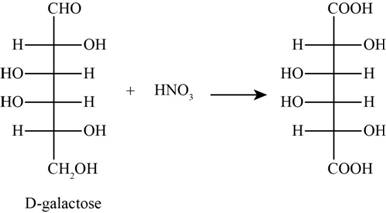
Figure 1
Explanation of Solution
The product obtained when D-galactose reacts with nitric acid is as follows,

Figure 1
b)
Interpretation:
The product obtained when D-galactose reacts with
Concept Introduction:
D-galactose is a monosaccharide molecule and it is sweet in taste as glucose. It is C-
Epimers are pair of stereoisoisomers which differ in configuration at one stereogenic center. In D-galactose molecule one terminal aldehydic and one terminal alcoholic group is present. The given ions
b)
Answer to Problem 34P
The product obtained when D-galactose reacts with
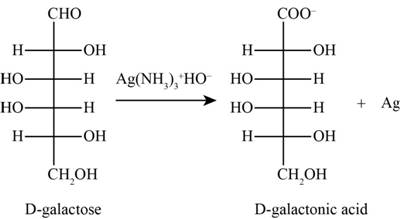
Figure 2
Explanation of Solution
The product obtained when D-galactose reacts with

Figure 2
The given ions
c)
Interpretation:
The product obtained when D-galactose reacts with
Concept Introduction:
D-galactose is a monosaccharide molecule and it is sweet in taste as glucose. It is C-
Epimers are pair of stereoisoisomers which differ in configuration at one stereogenic center. In D-galactose molecule one terminal aldehydic and one terminal alcoholic group is present.
c)
Answer to Problem 34P
The product obtained when D-galactose reacts with
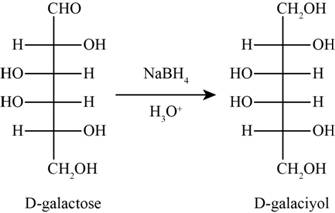
Figure 3
Explanation of Solution
The product obtained when D-galactose reacts with

Figure 3
The product obtained when D-galactose reacts with
d)
Interpretation:
The product obtained when D-galactose reacts with excess
Concept Introduction:
D-galactose is a monosaccharide molecule and it is sweet in taste as glucose. It is C-
d)
Answer to Problem 34P
The product obtained when D-galactose reacts with excess
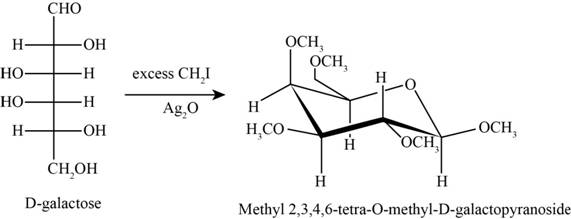
Figure 4
Explanation of Solution
The product obtained when D-galactose reacts with excess

Figure 4
e)
Interpretation:
The product obtained when D-galactose reacts with
Concept Introduction:
D-galactose is a monosaccharide molecule and it is sweet in taste as glucose. It is C-
e)
Answer to Problem 34P
The product obtained when D-galactose reacts with
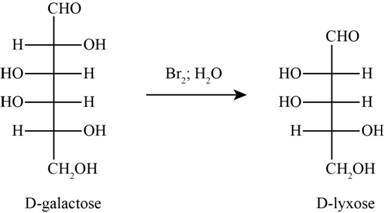
Figure 5
Explanation of Solution
The product obtained when D-galactose reacts with

Figure 5
f)
Interpretation:
The product obtained when D-galactose reacts with ethanol
Concept Introduction:
D-galactose is a monosaccharide molecule and it is sweet in taste as glucose. It is C-
f)
Answer to Problem 34P
The product obtained when D-galactose reacts with ethanol
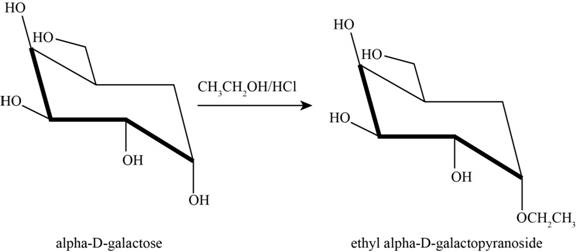
Figure 6
Explanation of Solution
The product obtained when D-galactose reacts with ethanol

Figure 6
g)
Interpretation:
The products obtained when D-galactose reacts with the given reactants are to be stated.
Concept Introduction:
D-galactose is a monosaccharide molecule and it is sweet in taste as glucose. It is C-
g)
Answer to Problem 34P
The products obtained when D-galactose reacts with the given reactants are shown in figure 7.
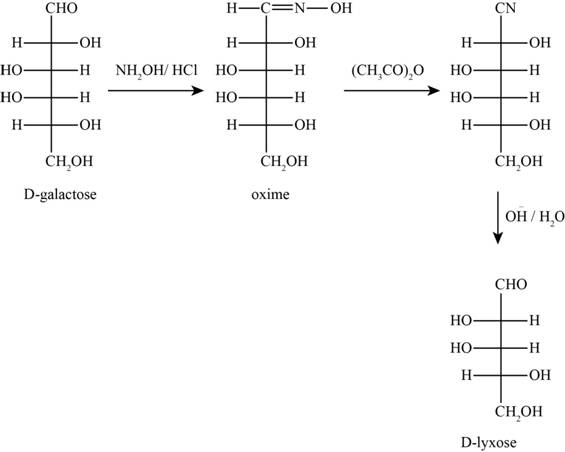
Figure 7
Explanation of Solution
The given reactants are hydroxylamine/trace acid, acetic anhydride/heat and
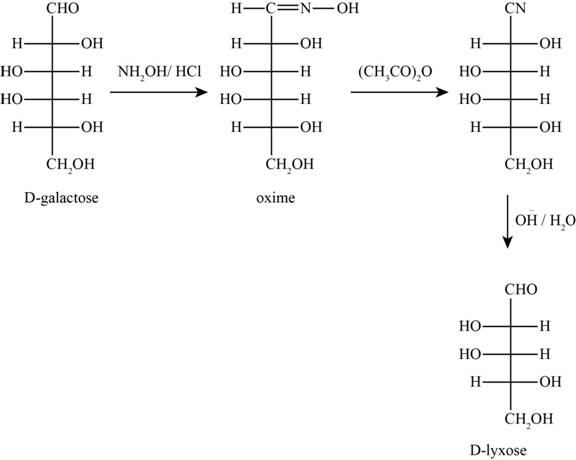
Figure 7
In the above reaction D-galactose first reacts with hydroxylamine in the presence of an acid, a compound of oxime is formed. Then it reacts with acetic anhydride with heat gives nitrile compound. Now, nitrile compound undergoes a reaction with base a compound D-Lyxose is formed.
Want to see more full solutions like this?
Chapter 20 Solutions
ORGANIC CHEMISTRY-W/S.G+SOLN.MANUAL
- 4. Read paragraph 4.15 from your textbook, use your calculated lattice energy values for CuO, CuCO3 and Cu(OH)2 an explain thermal decomposition reaction of malachite: Cu2CO3(OH)2 →2CuO + H2O + CO2 (3 points)arrow_forwardPlease sirrr soollveee these parts pleaseeee and thank youuuuuarrow_forwardIII O Organic Chemistry Using wedges and dashes in skeletal structures Draw a skeletal ("line") structure for each of the molecules below. Be sure your structures show the important difference between the molecules. key O O O O O CHON Cl jiii iiiiiiii You can drag the slider to rotate the molecules. Explanation Check Click and drag to start drawing a structure. Q Search X G ©2025 McGraw Hill LLC. All Rights Reserved. Terms of Use F 3 W C 3/5arrow_forward
- 3. Use Kapustinskii's equation and data from Table 4.10 in your textbook to calculate lattice energies of Cu(OH)2 and CuCO3 (4 points)arrow_forward2. Copper (II) oxide crystalizes in monoclinic unit cell (included below; blue spheres 2+ represent Cu²+, red - O²-). Use Kapustinski's equation (4.5) to calculate lattice energy for CuO. You will need some data from Resource section of your textbook (p.901). (4 points) CuOarrow_forwardWhat is the IUPAC name of the following compound? OH (2S, 4R)-4-chloropentan-2-ol O (2R, 4R)-4-chloropentan-2-ol O (2R, 4S)-4-chloropentan-2-ol O(2S, 4S)-4-chloropentan-2-olarrow_forward
- Use the reaction coordinate diagram to answer the below questions. Type your answers into the answer box for each question. (Watch your spelling) Energy A B C D Reaction coordinate E A) Is the reaction step going from D to F endothermic or exothermic? A F G B) Does point D represent a reactant, product, intermediate or transition state? A/ C) Which step (step 1 or step 2) is the rate determining step? Aarrow_forward1. Using radii from Resource section 1 (p.901) and Born-Lande equation, calculate the lattice energy for PbS, which crystallizes in the NaCl structure. Then, use the Born-Haber cycle to obtain the value of lattice energy for PbS. You will need the following data following data: AH Pb(g) = 196 kJ/mol; AHƒ PbS = −98 kJ/mol; electron affinities for S(g)→S¯(g) is -201 kJ/mol; S¯(g) (g) is 640kJ/mol. Ionization energies for Pb are listed in Resource section 2, p.903. Remember that enthalpies of formation are calculated beginning with the elements in their standard states (S8 for sulfur). The formation of S2, AHF: S2 (g) = 535 kJ/mol. Compare the two values, and explain the difference. (8 points)arrow_forwardIn the answer box, type the number of maximum stereoisomers possible for the following compound. A H H COH OH = H C Br H.C OH CHarrow_forward
 Introduction to General, Organic and BiochemistryChemistryISBN:9781285869759Author:Frederick A. Bettelheim, William H. Brown, Mary K. Campbell, Shawn O. Farrell, Omar TorresPublisher:Cengage Learning
Introduction to General, Organic and BiochemistryChemistryISBN:9781285869759Author:Frederick A. Bettelheim, William H. Brown, Mary K. Campbell, Shawn O. Farrell, Omar TorresPublisher:Cengage Learning Chemistry for Today: General, Organic, and Bioche...ChemistryISBN:9781305960060Author:Spencer L. Seager, Michael R. Slabaugh, Maren S. HansenPublisher:Cengage Learning
Chemistry for Today: General, Organic, and Bioche...ChemistryISBN:9781305960060Author:Spencer L. Seager, Michael R. Slabaugh, Maren S. HansenPublisher:Cengage Learning General, Organic, and Biological ChemistryChemistryISBN:9781285853918Author:H. Stephen StokerPublisher:Cengage Learning
General, Organic, and Biological ChemistryChemistryISBN:9781285853918Author:H. Stephen StokerPublisher:Cengage Learning Organic And Biological ChemistryChemistryISBN:9781305081079Author:STOKER, H. Stephen (howard Stephen)Publisher:Cengage Learning,
Organic And Biological ChemistryChemistryISBN:9781305081079Author:STOKER, H. Stephen (howard Stephen)Publisher:Cengage Learning,



